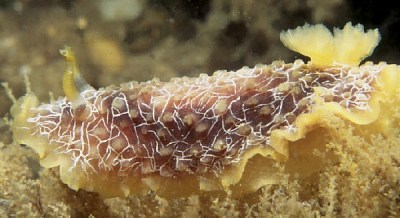
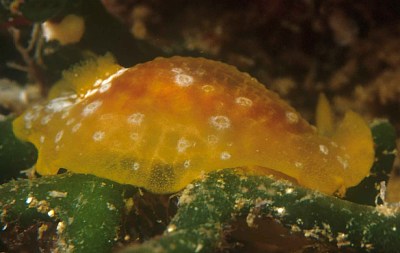
Doriopsilla areolata
Bergh, 1880
Order: NUDIBRANCHIA
Suborder: DORIDINA
Superfamily: EUDORIDOIDEA
Family: Dendrodorididae
DISTRIBUTION
Mediterranean, Atlantic coast of Europe to France.
PHOTO
Upper: Bassin d'Arcachon, Atlantic coast, France. approx 40 mm, May 23, 1998. Photo: Michel Barrabés.
Lower: Llafranc (Mediterranean coast of Spain), June 2002, at 14m. Size is 20mm. Photo: Patrick Heurtaux
Body and mantle range in colour from a translucent whitish cream to bright orange with a pattern of opaque white markings. The mantle is covered in low rounded tubercles. Sometimes these are surounded by a white ring, and sometimes the whole mantle is covered with a reticulate pattern of white lines. All variations can occur between these two colour extremes.
Valdes & Ortea (1997) propose 3 subspecies.
• D. areolata areolata [Europe, Mediterranean, Nth Africa] - typical colour pattern with reticulate white lines
• D. areolata albolineata [west Africa - Ghana - Angola] - white lines usually transeverse
• D. areolata nigrolineata [Caribbean] - network of black lines.
In external colour it is very similar to the Indo-West Pacific species Doriopsilla miniata but they differ in egg morphology and larval development. [see Kirsten Benkendorff's message].
References:
• Garcia, F.J., Garcia-Gomez, J.C. & Cervera, J.L. (1986) Estudio morfologico de las espiculas de Doriopsilla areolata (Gastropoda: Nudibranchia). Malacologia, 27(1): 83-96
• Valdes, A. & Ortea, J. (1997) Review of the genus Doriopsilla Bergh, 1880 (Gastropoda: Nudibranchia) in the Atlantic Ocean. The Veliger, 40(3): 240-254.
Rudman, W.B., 2002 (August 11) Doriopsilla areolata Bergh, 1880 . [In] Sea Slug Forum. Australian Museum, Sydney. Available from http://www.seaslugforum.net/find/doriareo
Related messages
Re: Doriopsilla and developmental strategies
May 24, 2006
From: Jeff Goddard
Concerning message #16633:
Hi Bill,
Seeing Skip Pierce's message [#16633] led me to your messages [#16513] and [#10469 ] about mode of development and the potential relationship between the externally similar, but apparently geographically isolated, Doriopsilla areolata and D. miniata. The existing data on the development of these two species now appears to blur the distinctions between them, rather than separate them.
As you know, Valdés and Ortea (1997) described three subspecies of Doriopsilla areolata:
(1) D. areolata areolata from the Mediterranean and NE Atlantic,
(2) D. areolata albolineata from the eastern tropical Atlantic, and
(3) D. areolata nigrolineata from the Caribbean Sea.
The latter subspecies has large eggs and direct development (Gonsalves-Jackson,(2004). Valdés and Ortea (1997) reported a mean egg size of 106 microns for D. areolata areolata. This is consistent with the Marina Poddubetskaia's photos from Senegal [message #10345 ] and also indicates planktotrophic development in members of this family (Goddard 2005). However, Valdés and Ortea (1997) pointed out that Ballesteros and Ortea (1980) reported eggs ranging from 209 to 266 microns in diameter for D. evanae, which according to Valdés and Ortea (1997) is a junior synonym of D. areolata areolata. Eggs this large almost certainly indicate direct development.
Therefore, based on developmental mode, one or two of the subspecies of Doriopsilla areolata might actually be the same as D. miniata. This seems ripe for a genetic analysis, and it would be most interesting to confirm the large egg size reported by Ballesteros and Ortea (1980) for specimens from northeast Spain. It would also be interesting to examine egg size and mode of development of D. miniata from Indo-Pacific sites other than New South Wales, where Rose (1985) reported its direct development. Would I love to hop on some airplanes for this!
-
Ballesteros, M. and Ortea, J.A. (1980) Contribucion al conocimiento de los Dendrodorididae (Moluscos: Opistobranquios: Doridaceos) del litoral Iberico. 1. Publicaciones del Departmento de Zoologia, Universida de Barcelona 5: 25-37.
-
Goddard, J.H.R. (2005) Ametamorphic direct development in Dendrodoris behrensi (Nudibranchia: Dendrodorididae), with a review of developmental mode in the family. Proceedings of the California Academy of Sciences 56: 201-211.
-
Gonsalves-Jackson, D. C. (2004) Opisthobranch mollusks across the Isthmus of Panama: systematics and biogeographic distribution of developmental types. Ph.D. Dissertation, Florida Institute of Technology, Melbourne, Florida.
-
Rose, R.A. (1985) The spawn and development of twenty-nine New South Wales opisthobranchs (Mollusca: Gastropoda). Proceedings of the Linnean Society of New South Wales 108:23-36.
-
Valdés, A. and J. Ortea. (1997) Review of the genus Doriopsilla Bergh, 1880 (Gastropoda: Nudibranchia) in the Atlantic Ocean. The Veliger 40:240-254.
Best wishes,
Jeff
goddard@lifesci.ucsb.edu
Goddard, J.H.R., 2006 (May 24) Re: Doriopsilla and developmental strategies. [Message in] Sea Slug Forum. Australian Museum, Sydney. Available from http://www.seaslugforum.net/find/16666Dear Jeff,
I knew there was some reason I have put D. miniata in the 'too hard' basket. One thing I can do is ask anyone who see either of these species laying eggs to take a closeup photo. Certainly I can only recall seeing New South Wales specimens laying large eggs, but I have only one pair of eyes. Perhaps it has more than one development type in New South Wales? As well as knowing what type of eggs D. miniata lays elsewhere in the Indo-West Pacific it would be nice to know if the size of the eggs were variable in one geographic locality.
Best wishes,
Bill Rudman
Doriopsilla areolata from Portugal?
May 16, 2006
From: David Abecasis
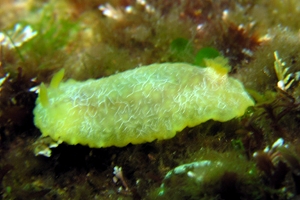
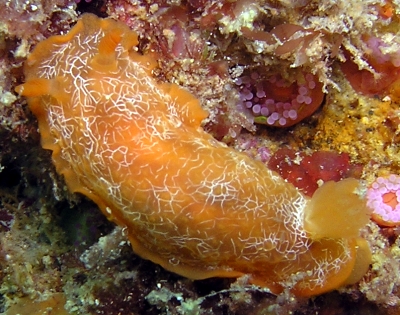
Hi Bill,
I'm sending what I believe to be two different colour patterns of Doriopsilla areolata.
Locality: Praia do Burgau, Lagos, 8 metres, Portugal, Atlantic Ocean, 30 April 2006, wreck in sandy bottom. Photographer: David Abecasis.
Best wishes,
David Abecasis
davidbecas@netcabo.pt
Abecasis, D., 2006 (May 16) Doriopsilla areolata from Portugal?. [Message in] Sea Slug Forum. Australian Museum, Sydney. Available from http://www.seaslugforum.net/find/16513Dear David,
I am sure these are both colour forms of D. areolata. The Indo-West Pacific species. D. miniata, has a very similar colour pattern and same range of colour variation. If it were not from their different developement strategies [see message #10469] I would suspect they were the same species.
Best wishes,
Bill Rudman
Doriopsilla areolata from Spain
February 23, 2004
From: Juan Luis
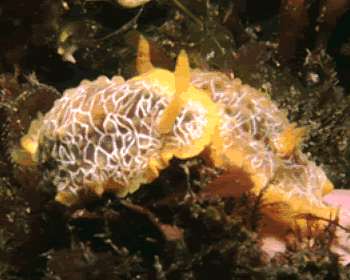
Dear Bill
Could anyone tell me what species is this? The photo was taken in Northern Spain. Thanks
Juan Luis
jluism@correo.uniovi.es
Juan Luis, 2004 (Feb 23) Doriopsilla areolata from Spain. [Message in] Sea Slug Forum. Australian Museum, Sydney. Available from http://www.seaslugforum.net/find/12265Dear Juan Luis,
This is Doriopsilla areolata, which I understand can be quite common in northern Spain
Best wishes
Bill Rudman
Doriopsilla areolata from French Mediterranean
July 30, 2003
From: Marina Poddubetskaia
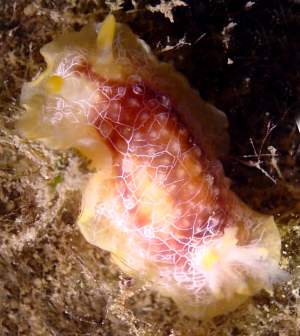
Dear Bill,
Here is Doriopsilla areolata from Cerbere. This animal looks much more like Atlantic specimens on the Forum, rather than the one on Patrick Heurtaux's photo from the Mediterranean.
Date: July 06, 2003
Location: Cerbere, France, Mediterranean coast
Site: Sec de Joel
Depth: 33m
Size: 30-35mm
Photos: Marina Poddubetskaia - Nembro website
Best wishes,
Marina.
nembro@nembro.info
Poddubetskaia, M., 2003 (Jul 30) Doriopsilla areolata from French Mediterranean. [Message in] Sea Slug Forum. Australian Museum, Sydney. Available from http://www.seaslugforum.net/find/10558Thanks Marina,
I'm sure Patrick's animal represents just one colour variation found in the Mediterranean, and probably outside as well. In Valdes & Ortea (1997) review they have a photo, very like yours, of D. areolata from the Mediterranean
Best wishes,
Bill Rudman
Colour variation in Doriopsilla areolata
July 5, 2003
From: Marina Poddubetskaia
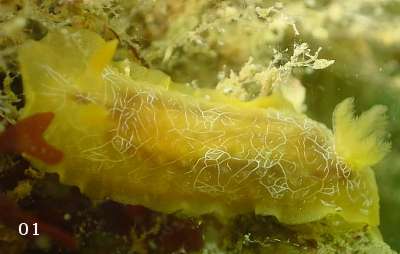
Dear Bill,
You seem to be interested in colour variation in Doriopsilla areolata. In Senegal I took a lot of photos of this species. So, I can contribute more with a range of 4 tinges. All photos were taken with the same light spot.
Photo 1: Dakar, Senegal, Eastern Atlantic. Site: Terou baye Sogui. Depth: 4m. June 05, 2003. Size: 20mm
Photos 2, 3 & 4: Dakar, Senegal, Eastern Atlantic. Site: Cap Manuel., Depth: 5-6m., May 29, 2003. Size: (2 & 4): 25mm., (3): 20-25mm
Photos: Marina Poddubetskaia - Nembro
website
Best regards,
Marina
nembro@nembro.info
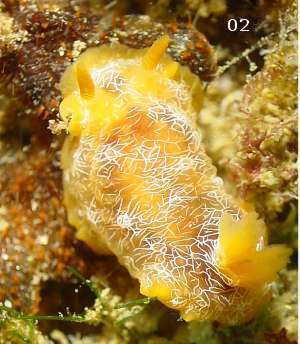
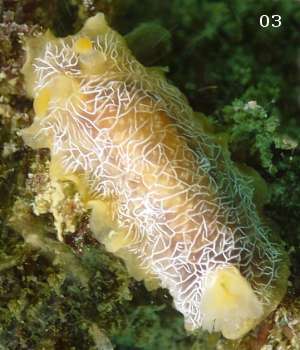
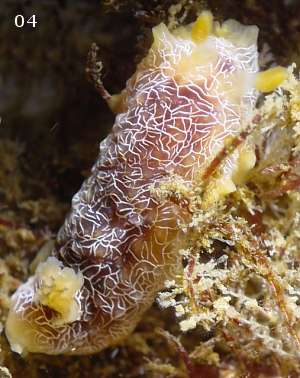
Dear Marina,
I'm always interested in learning more about colour variation in all opisthobranchs, and in particular animals like these dendrodorids where we haven't got much else to go on in characters. The more I see of Doriopsilla areolata the more I wonder whether the Indo-West Pacific Doriopsilla miniata is the same species. Knowing more about the colour variability in D. areolata will be useful when the two 'species' are compared.
Best wishes,
Bill Rudman
Doriopsilla areolata and its egg-ribbons
July 3, 2003
From: Marina Poddubetskaia
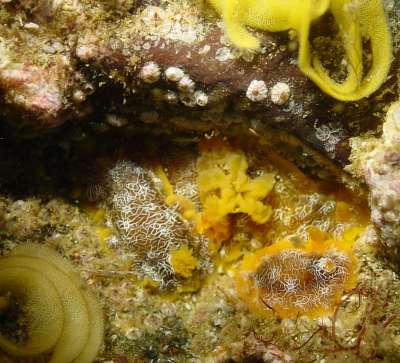
Dear Bill,
You have already photos of Doriopsilla areolata from Dakar on the Forum. Here are some more photos: an animal laying eggs and some egg-ribbons. In Senegal this species is really common in shallow waters and related egg-ribbons are as numerous as animals.
Location : Dakar, Senegal, Eastern Atlantic
Site: Cap Manuel, May 29, 2003. Depth: 5-6m
Size: Animals ranged in size from 25-30mm
Photos: Marina Poddubetskaia - Nembro website
Cordially,
Marina.
nembro@nembro.info
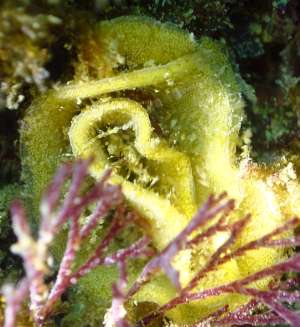
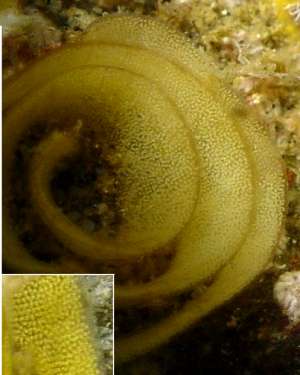
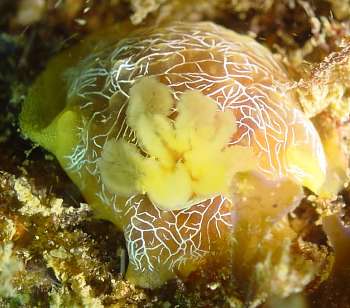
Dear Marina,
Thanks for this interesting series of photos. I will have to check my records for photos of the egg ribbon of the Indo-West Pacific species D. miniata, because the more I see of the Atlantic species the more alike they seem. I have copied a photo of the cluster of animals together into a second message to illustrate some of the colour variation.
Best wishes,
Bill Rudman
Doriopsilla areolata from Senegal
July 3, 2003
From: Marina Poddubetskaia
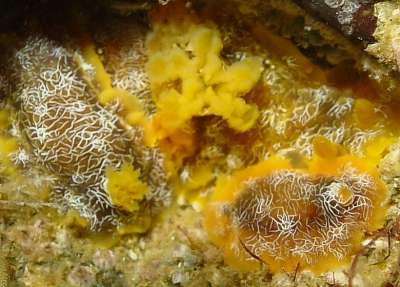
To accompany my message on Doriopsilla areolata egg laying in Senegal, here is a photo of a cluster of animals showing some the colour variation.
Dakar, Senegal, Eastern Atlantic, Site: Cap Manuel, May 29, 2003. Depth: 5-6m., Size: 25-30mm. Photo: Marina Poddubetskaia - Nembro website
Cordially,
Marina.
nembro@nembro.info
Poddubetskaia, M. , 2003 (Jul 3) Doriopsilla areolata from Senegal. [Message in] Sea Slug Forum. Australian Museum, Sydney. Available from http://www.seaslugforum.net/find/10368Thanks Marina,
Bill Rudman
Doriopsilla areolata from Senegal
April 4, 2003
From: Marina Poddubetskaia
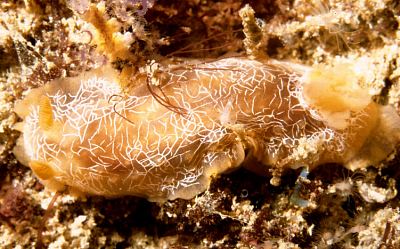
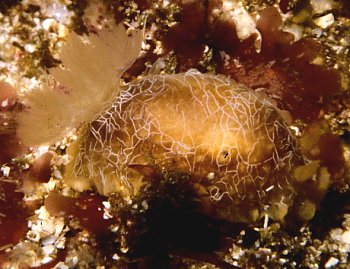
Dear Bill,
Here are other photos from Dakar, Senegal.
These Doriopsilla areolata were also taken by Patrice Petit de Voize [PdeVoize@aol.com] on the Tacoma wreck in April 2001.
Best wishes,
Marina (and Patrice)
nembro@nembro.info
Poddubetskaia, M., 2003 (Apr 4) Doriopsilla areolata from Senegal. [Message in] Sea Slug Forum. Australian Museum, Sydney. Available from http://www.seaslugforum.net/find/9486Dear Marina and Patrice,
Malcolm Edmunds (1968) described a new species, Doriopsilla albolineata, from Ghana which he differentiated from D. areolata by some constant colour differences. The background colour was 'grey, sometimes yellowish, but never yellow', and the white lines on the mantle were almost all tranverse rather than forming a network. In a recent review of the Atlantic species of Doriopsilla, Valdes & Ortea (1997) describe further material from Angola and note that the background colour can range from pearl grey to yellow. They consider the west African form to be a subspecies D. areolata albolineata. Your photos from Senegal, have the typical network of white lines, so they fit the Valdes & Ortea's typical subspecies D. areolata areolata. If these subspecies are real, I guess Senegal must be on the southern boundary between the two subspecies.
• Valdes, A. & Ortea, J. (1997) Review of the genus Doriopsilla Bergh, 1880 (Gastropoda: Nudibranchia) in the Atlantic Ocean. The Veliger, 40(3): 240-254.
Best wishes,
Bill Rudman
Re: Doriopsilla areolata from the Mediterranean
March 4, 2003
From: Erwin Köhler

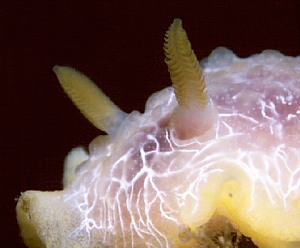
Dear Bill,
Here are 2 shots from the Atlantic coast of France showing the typical lines, which as you said are very similar to D. miniata.
Data:
Size: approx 40 mm
Depth: unrecorded
Date: May 23, 1998
Country: France
Region: Bassin d'Arcachon
Divesite: Hortense
The shots were made by Michel Barrabés,
m.barrabes@libertysurf.fr
Cheers,
Erwin
Erwin@medslugs.de
Köhler, E., 2003 (Mar 4) Re: Doriopsilla areolata from the Mediterranean. [Message in] Sea Slug Forum. Australian Museum, Sydney. Available from http://www.seaslugforum.net/find/9239Thanks Erwin,
Bill Rudman
Doriopsilla areolata from the Mediterranean
August 13, 2002
From: Patrick Heurtaux

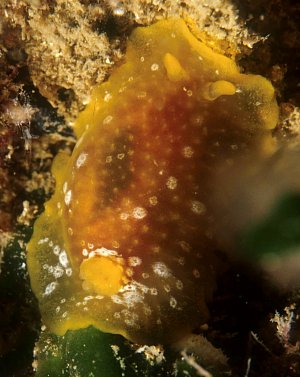
Dear Bill,
Here are two photos of a mediterranean dorid that I can't identify....
I found this slug at Llafranc (Mediterranean coast of Spain), in June, at 14m deep, and it was hidden under a Codium. The size is 20mm. The only other time than I saw this dorid was in 1994, under a stone at Cerbere (France), 10m deep.
Best regards
Patrick Heurtaux
pheurtau@club-internet.fr
Heurtaux, P., 2002 (Aug 13) Doriopsilla areolata from the Mediterranean. [Message in] Sea Slug Forum. Australian Museum, Sydney. Available from http://www.seaslugforum.net/find/7660Dear Patrick,
I am pretty sure this is Doriopsilla areolata. Usually it has a reticulate pattern of thin white lines on the mantle but sometimes all that can be seen of the pattern is this arrangement of irregular white rings around some of the low tubercles. It is very similar externally to the Indo-West Pacific species D. miniata.
Best wishes,
Bill Rudman
